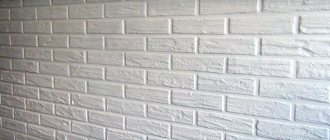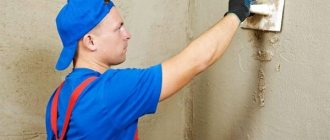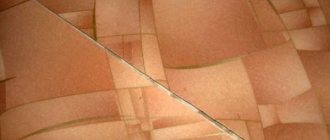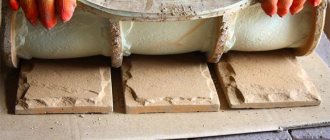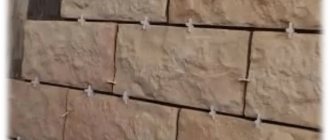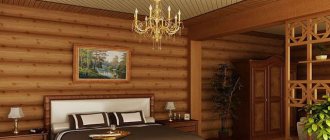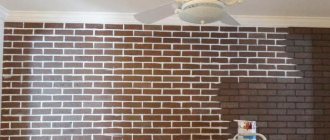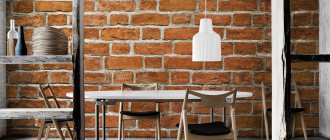Specifics of imitation brickwork
Why imitation brick for interior decoration is more profitable than natural stone masonry:
- pressure on the slabs - due to the light weight and thickness of the materials, the load on load-bearing walls is eliminated, which guarantees safe living;
- apartment area - imitation masonry is suitable even for a small square footage, since the volume of the space will be practically preserved;
- price category - this method of wall finishing will cost much less than buying real bricks.
The process of laying materials takes less time and is understandable even to an untrained person. Externally, the surface is almost no different from natural stonework.
“Brick” wallpaper in the living room Source sense-life.com
Tips and tricks for finishing brick walls
Finally, here are a few tips that will help you correctly decorate a room using this effect:
- it is better to cut the bricks in sizes similar to the original, then they will look more believable;
- It is permissible to use not only a standard color, the surface can be painted from white to dark brown;
- in rooms with this interior, additional lighting should be installed;
- You shouldn’t use too many bricks in one room; it’s better to finish one wall so that the room doesn’t look like a basement;
- This coating is easy to clean; simply wipe the surface with a damp cloth;
- plaster can be applied in various techniques (“path”, “Gothic style and others), which will help you choose the appropriate option.
You should not use too many bricks in one room; it is better to finish one wall so that the room does not look like a basement.
Decorating the walls with decorative bricks will help transform the room and create a unique style.
This is a modern design that many may like, the main thing is not to overdo it in its use. It is better to prepare the project in advance in order to calculate where the finishing material will be installed and how much will need to be purchased. As a result, you can get an interior that will please the eye.
Briefly about the main thing
Imitation of brickwork is an original and budget-friendly way to decorate and refresh the interior of a room. However, you should be careful, because this method of decoration visually reduces the space. That is why designers advise not finishing the entire room, but only part of it.
Knowing 6 ways to imitate a natural brick wall using various materials, you can choose the most optimal option in terms of price and execution technology. All presented masonry methods are accessible to everyone and allow you to create your own decor.
Ratings 0
Methods for creating a brick wall using ready-made finishing materials
The main advantages of products imitating brick are the absence of pressure on the slabs due to their light weight and small thickness, due to which volume is not stolen from the space. Also, it costs much less than real stone. It is much more convenient and faster to work with it.
Spectacular look of ceramic tiles
There are different options for finishing materials in stores. Among them are several types of tiles, rolled wallpaper, and wide panels. Each decorative element has its own advantages and disadvantages.
The complexity and speed of the installation process differ for each method. Carefully read all the instructions and choose the best option. Be sure to consider the physical properties of materials.
Soft tiles
It leads in ease of installation and processing. It has bright decorative qualities; it is almost impossible to distinguish it from the original texture. Suitable not only for interior rooms, but also for decorating balconies, loggias, terraces, external columns or building walls.
Flexible tiles are available in a wide range of colors
Thanks to its elastic, bendable structure, it is convenient to lay it on rounded surfaces, in corners, for cladding small architectural forms. The product is sold in a variety of colors, which allows you to combine shades in an interesting way and create eye-catching compositions.
Advantages of facing material
Let's consider the advantages of soft tiles and find out the reasons for their incredible popularity among master finishers:
- It is resistant to environmental factors, temperature changes, humidity, pressure
- Gives the surface an aesthetic and stylish appearance
- Additionally protects walls from damage and insulates the room
- Strong and durable, not afraid of impacts, does not crack, does not dry out and does not split
- Not afraid of pathogenic microorganisms, including fungi, mold, parasites
- Not affected by UV rays, does not fade in direct sunlight
- Fits perfectly in inner and outer corners without creases or bubbles
The perfect "fake"
The products are resistant to high temperatures, practically do not burn, and immediately melt and extinguish. This is the most important factor from a safety point of view in case of an unexpected fire.
What you will need
First of all, prepare everything you need:
- Flexible tiles (check the quantity with the sales consultant, having previously measured the area)
- Primer
- Glue
It is best to buy a bucket of ready-made mixture for tiles, which you will not have to dilute and bring to the desired consistency . However, the dry mixture will also work if there are compelling reasons in its favor. Be sure to consult the store about which glue is best to use for working with the selected material, and read the recommendations in the instructions for the tiles.
Universal adhesive for flexible stone
- 2 spatulas : smooth and toothed, 15-20 cm wide. The depth of the teeth of the latter should be 4-8 mm. The first is needed to apply glue to the surface, and the second will help to evenly distribute the substance, which will ensure better adhesion
- Construction level and long ruler (1-1.5 m). If you allow the slightest unevenness or bevel away from the right angle, after just a couple of rows they will become visually obvious. The neatness and perfection of the appearance will be hopelessly spoiled
- Marking cord
- Brush 1 cm wide for finishing tile joints
- Simple pencil and scissors
Installation stages
1At the first stage, carefully prepare the wall. It is leveled, sanded, and cleaned of the old coating.
2Next, they go over it with a primer, which has antiseptic qualities. This will protect your decor from mold and mildew. Provides a more tenacious connection between the tile and the wall.
Wait until the primer is completely dry. They begin to work in a room where the air temperature is not lower than 5°C.
3 Markings are applied to the entire surface with a simple pencil. Be sure to determine the bottom and top row of masonry. Use a ruler and level.
The visual simplicity of tiling corners and outer edges of walls with soft tiles
4 Stir the glue with a flat tool and apply it to an area 1 m wide and 0.5 m high. The layer thickness should be no more than 3-4 mm.
5 Carefully level the adhesive mass with a notched spatula.
6Lay out the first row, working from bottom to top. If the first one started with a whole tile, then the second one is continued with half or a third, depending on the desired type of masonry. Cut the tiles with simple scissors.
7 Gently press the material against the wall and gently smooth it over the entire area.
8Make sure that the distance between the rows is the same. This will keep the seams looking neat.
9Before applying glue to the next area, go over the seams with a thin brush dipped in water. Smooth both vertical and horizontal grooves.
Before starting laying, remove all tiles from the packages and thoroughly mix them together. This way you will evenly distribute the products, the shades of which may vary minimally.
Volumetric panels with imitation brick
Ready-made panels are large in size, so their installation is much faster. They are glued end to end, in rows, like puzzles. They cover a large area of the surface at once, so this cladding can easily be done with your own hands.
Cladding panels with a characteristic check pattern
Types of products
There are different types of panels, depending on the material from which they are made:
- Hardboard (compressed wood waste)
- Fiberboard
- Fiberglass
- Gypsum
- Glass fiber reinforced concrete (cement with glass fibers). Very durable but heavy material
- Polyvinyl chloride (PVC)
- Modified fibreboards (MDP)
Sample of PVC sheet panel
For interior decoration, the last two varieties are most often used. PVC is high-quality plastic, and MDP is wood boards with plastic elements.
Let's look at the advantages of such structures:
- Durability and resistance to environmental influences
- Plastic is not afraid of chemical detergents and is not susceptible to mold or corrosion.
- Easily cleaned from dust, dirt, grease, yellow deposits
- Provides excellent sound insulation
- In case of mechanical damage to a certain area, the block can be easily replaced without destroying the entire masonry
- The material is very light
- Installation technology is simple and fast
- Low prices. Due to the large area, fewer slabs are required
- Optimal material for a room with high traffic, which is subject to changes in temperature and humidity: kitchen, bathroom, loggia, hallway
- Panels can be easily cut with an electric jigsaw or hacksaw
- They perfectly mask unevenness and imperfections of the wall and do not require their preliminary preparation.
- When mounted on a frame, the panel perfectly masks utility lines: pipes, wires, recesses
Cladding the balcony with MDP panels
There are models with insulation, which are supplemented with foam or mineral wool on the reverse side. They are suitable for cladding balconies or cold verandas in country houses.
Wall installation
Depending on the direction of the pattern, the panels are attached to the wall vertically or horizontally directly with screws or self-tapping screws. The sheets are perfectly glued to a flat surface using liquid nails or any other polymer glue. Heavy blocks can be placed on a cement adhesive mass.
There are designs that are installed on special frames that are attached to the wall with dowels. If the surface is not level, you will need a special subsystem of metal slats or wooden beams. Many panel manufacturers sell ready-made frames with hooks on which the blocks are hung.
Sample of fastening to a frame subsystem
If you purchase panels separately from the frame, make sure they match each other so that they can be used for a single installation. It is best to purchase designs from one manufacturer.
Gypsum tiles
It belongs to a variety of rigid facing materials and is considered the most economically advantageous option. It is very light and aesthetically attractive, allowing you to reliably imitate brickwork.
Elegant appearance of gypsum tiles
The disadvantage is the impossibility of decorating in rooms with high humidity, since gypsum is considered a highly hygroscopic rock. However, there are specimens on sale with additional moisture-proof layers on the inside and outside of the stone. These tiles can even be installed in bathrooms.
In addition to ordinary rectangular tiles, you can find shaped specimens in the form of corners, squares, and triangles on sale . Such material must be glued to a composition containing gypsum. To create aesthetic seams, it is necessary to purchase grout, which is used to fill the space between the rows.
Cement tiles
This material is very strong, durable, and resistant to low temperatures. Consists of sand, cement and water. Available in a variety of textures and shades.
By the way, you can make such tiles yourself if you find a silicone mold. Mix the solution with water and two equal parts of sand and cement until the consistency of thick sour cream. Pour it into the mold and wait until it dries completely.
Cement tiles disguised as “wild stone”
Homemade tiles require external decoration, as well as the application of paint or a varnish layer. It can be tinted and a protective coating applied.
Clinker tiles
The most expensive option, but also the most effective. This finish looks expensive, noble, and elegant. The tile has the highest performance qualities.
Impeccable interior with clinker tiles at the head of the ensemble
It is made from natural, plastic clay, which is pressed and fired at high temperatures. The result is an environmentally friendly and natural material that can be used to cover existing fireplaces, stoves, internal and external walls. It will last a long time without losing its bright appearance.
Clinker tiles are decorated in a variety of ways. Its surface can be smooth, rough, glazed or “raw”. There are dozens of colors and textures.
How to properly stick hard material onto a vertical surface
The process of gluing decorative tiles
Solid tiles are mounted on the wall following the same algorithm. Only the type of adhesive composition can differ. Choose the one that is preferable for the material from which the tile is made: gypsum, cement, clay, etc.
Process technology:
The same tools are prepared from the inventory that are listed in the section on installing soft tiles. Add a grinder with a disk designed for cutting stone or a hand-held circular saw.
Due to the severity of the material, the procedure is considered more difficult. It also includes an additional final step for sealing the seams.
1The wall is leveled, cleaned, coated with primer
2Carefully mark with a simple pencil. They mark the upper and lower boundaries of the masonry, calculate the number of rows between them, and draw perfectly straight lines
When calculating the distance between the rows, do not forget about the gaps for the seams. The average thickness of a seam in brickwork is 8-12 mm.
3Prepare the glue
4 Carefully study the instructions for the package with the tiles. Some heavy materials also need to be treated with glue on the inside
5 Apply glue to the wall and level it with a notched trowel
Clinker installation
6Press the tile to the surface for 10 seconds. Start working from the bottom up
Don’t be lazy to check the evenness and symmetry of each row with a level.
7To make identical seams, wooden slats or special calibrators are temporarily inserted between the rows. After the adhesive has set, they are removed and transferred to the next row.
8When the laying is completed, the seams are filled with a special grout. It is placed in a plastic bag with a corner cut off, and carefully squeezed into the hole. Work carefully so that the mixture does not fall on the outside of the tile.
Brick-look wallpaper
Wallpaper with a brick pattern is an inexpensive and labor-intensive way to add charm and sophistication to your interior. They look especially advantageous in the office, kitchen, and hallway. The appearance of the rooms changes quickly and irrevocably.
Wallpaper with this pattern looks stylish and catchy
Please note that if the entire room is covered with wallpaper, such a print will visually reduce the space. Therefore, decoration is only permissible in large rooms.
Wallpaper is glued in the traditional way, without any special recommendations or additional instructions.
Clinker
The strength characteristics and elasticity of such a material are achieved by the presence of varieties of refractory clays. They are fired at very high temperatures.
This product is practically indestructible and lasts for a long time. Having low weight, it reduces the pressure of the load on the wall. He is not afraid of heat, cold, or precipitation. Complete imitation of the appearance of brick.
Such obvious advantages do not greatly affect the cost. Prices are affordable. An excellent choice would be a glossy facing version of brick-like tiles, which resemble it only in shape.
What is the peculiarity of the material
The original purpose of finishing with brick-like tiles for external cladding quickly gave way to interior decoration. With its help you can create unusual compositions that are unique in appearance. Certain advantages inherent in decorative brick tiles are:
- Originality of the drawing;
- Excellent environmental characteristics;
- Possibility of designing the most inaccessible places;
- Easy installation;
- Resistance to any external influence;
- Excellent combination with other decorative elements;
- Providing additional thermal insulation;
- Light load compared to bricks;
- Reasonable price.
A wide choice for buyers is indicated by a variety of brick-look tiles in Leroy Merlin. We offer a wide range of similar types of products, different textures and colors. Here you can purchase at low prices the types of gypsum tiles that match brickwork for the interior of your home, as well as suitable options for the exterior framing of your home.
Wall decoration variations
During design work, real brick is replaced with other materials that are structurally similar to it. For example, decorative finishing of brick walls can be done using:
- Panels used in construction
- Clinker tiles
- Plasters for decoration
- Specialized paint
The main quality of the described materials, which distinguishes them favorably from real brick, is their light weight and high compactness. Which decoration method should I choose for finishing brick walls? Let's take a closer look at the most common decoration methods. Having understood the nuances of each of them, you can easily recreate the design of the room you like at home.
Gypsum tile base
The most inexpensive material when using decorative brick tiles for finishing is gypsum. However, it is quite fragile. Absolutely not suitable for places with strong temperature changes and constant presence of moisture. Therefore its advantages such as:
- price equivalent;
- variety of color shades;
- amazing lightness;
- the ability to create a pleasant feeling of a cozy environment,
Can be used in the living room and hallway. The version of the room with white brick tiles looks especially good. It gives a feeling of comfort and a soft, pleasant atmosphere.
Separately, it is worth mentioning that the room is provided with additional sound insulation and low thermal conductivity, which provide a comfortable aura in the spatial zone designed in this way. Gypsum does not burn and is an absolutely clean material from an environmental point of view.
It is not suitable for kitchens, baths and uninsulated balconies.
Note!
Epoxy grout for tiles: pros and cons, scope, varieties, how to work with it (instructions + photos)
Do-it-yourself tile shower tray step by step: instructions, dimensions, design, installation of communications, types of structures, photos
White tiles in the bathroom: 170 photos of the best ideas and new tile designs. Layout schemes and beautiful combinations
Specialized paint
A good way to imitate brickwork is by painting. The color of the brick can be chosen depending on your mood or the overall tone of the room. Experts consider elastomeric material to be the most suitable option for “brick” painting. Reliably filling the damage to the wall, it forms a shrinkage of the working surface. With a high degree of protection against water and other contaminants, this one remains fresh and practical for many years.
A wide range of colors is provided by acrylic and water-based paints; they are applied with a brush, roller or other suitable tools.
Positive sides:
- Environmentally friendly finishing material
- Easy to apply
- Practical and good protection against dirt
- Cheap finishing
Negative points:
- No protection against mechanical damage
- Over time, it loses its visual appeal
- Requires a flat surface
- Color may differ from that stated on the package
